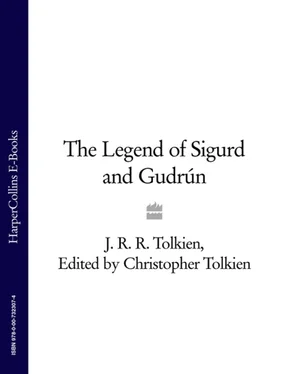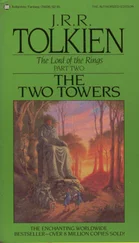J. Tolkien - The Legend of Sigurd and Gudrún
Здесь есть возможность читать онлайн «J. Tolkien - The Legend of Sigurd and Gudrún» — ознакомительный отрывок электронной книги совершенно бесплатно, а после прочтения отрывка купить полную версию. В некоторых случаях можно слушать аудио, скачать через торрент в формате fb2 и присутствует краткое содержание. Жанр: Старинная литература, на английском языке. Описание произведения, (предисловие) а так же отзывы посетителей доступны на портале библиотеки ЛибКат.
- Название:The Legend of Sigurd and Gudrún
- Автор:
- Жанр:
- Год:неизвестен
- ISBN:нет данных
- Рейтинг книги:5 / 5. Голосов: 1
-
Избранное:Добавить в избранное
- Отзывы:
-
Ваша оценка:
- 100
- 1
- 2
- 3
- 4
- 5
The Legend of Sigurd and Gudrún: краткое содержание, описание и аннотация
Предлагаем к чтению аннотацию, описание, краткое содержание или предисловие (зависит от того, что написал сам автор книги «The Legend of Sigurd and Gudrún»). Если вы не нашли необходимую информацию о книге — напишите в комментариях, мы постараемся отыскать её.
The Legend of Sigurd and Gudrún — читать онлайн ознакомительный отрывок
Ниже представлен текст книги, разбитый по страницам. Система сохранения места последней прочитанной страницы, позволяет с удобством читать онлайн бесплатно книгу «The Legend of Sigurd and Gudrún», без необходимости каждый раз заново искать на чём Вы остановились. Поставьте закладку, и сможете в любой момент перейти на страницу, на которой закончили чтение.
Интервал:
Закладка:
20 ‘toft’: homestead.
29 In the Saga the sons of Völsung were set in stocks in the forest to await the old she-wolf who came each night. Signý, on the tenth day, sent her trusted servant to Sigmund, who alone survived, to smear honey over his face and to put some in his mouth. When the wolf came she licked his face and thrust her tongue into his mouth; at which he bit into it. Then the wolf started back violently, pressing her feet against the stocks in which Sigmund was set, so that they were split open; but he held on to the wolf’s tongue so that it was torn out by the roots, and she died. ‘Some men say,’ according to the Saga, ‘that the wolf was King Siggeir’s mother, who had changed herself into this shape by witchcraft.’
While in the Saga the stocks are an important element in the story at this point, in the Lay there is no suggestion of stocks, but only of fetters and shackles; the wolf is ‘torn and tongueless’, but ‘by the tree riven’. See the note on stanzas 30-32.
30–32 This passage is very greatly condensed, and elements in the Saga essential to the narrative are passed over. Thus in the Saga, Signý found Sigmund in the woods, and it is explicit that they decided that he should make a house for himself under the ground, where Signý would provide for his needs. There is nothing in the Saga to explain Signý’s words in the Lay ‘Dwarvish master, thy doors open!’ In the opening prose passage of this section (p.72) it is said that ‘Sigmund dwelt in a cave in the guise of a dwarvish smith.’
In this connection it is curious, if nothing more, to observe that in William Morris’ poem The Story of Sigurd the Volsung Sigmund’s dwelling is explicitly ‘a stony cave’ that was once ‘a house of the Dwarfs’. It is also said in that poem (see the note to stanza 29) that by Siggeir’s orders the men who led the sons of Völsung into the forest cut down the greatest oak-tree that they could find and bound them to it ‘with bonds of iron’; and when the wolf came for Sigmund he ‘burst his bonds’ and slew it with his hands.
Signý had two sons by Siggeir, and when the elder was ten years old she sent him out to Sigmund in the forest to be a help to him should he attempt to avenge Völsung; but the boy, told by Sigmund to make the bread while he himself went out for firewood, was frightened to touch the bag of flour because there was something alive in it. When Sigmund told Signý about this she told him to kill the boy, since he had no heart; and Sigmund did so. The next year Signý sent her second son by Siggeir out into the woods, and things went in the same way.
After that Signý changed shapes with a sorceress, and the sorceress slept with Siggeir for three nights in Signý’s form, while Signý slept with her brother. The son born to them was named Sinfjötli.
33 On lines 5–6 of this stanza see the note to 35–36.
‘bast’: flexible bark, used for making baskets, and for tying.
33–34 In the Saga Sigmund subjected Sinfjötli to the same test as Siggeir’s sons, and when he came back to the underground house Sinfjötli had baked the bread, but he said that he thought that there had been something alive in the flour when he started kneading it. Sigmund laughed, and said that Sinfjötli should not eat the bread he had baked, ‘for you have kneaded in a great venomous snake.’ There is no mention in the Saga of Sinfjötli’s bringing Sigmund’s sword (see note to 37–39).
35–36 A long passage is devoted in the Saga to the ferocious exploits of Sigmund and Sinfjötli in the forest, where they became werewolves; and it is an important point that Sigmund thought that Sinfjötli was the son of Signý and Siggeir (cf. 33 ‘Fair one, thy father / thy face gave not’), possessing the energy and daring of the Völsungs but the evil heart of his father.
37–39 In the Saga Sigmund and Sinfjötli entered Siggeir’s hall and hid themselves behind ale barrels in the outer room; but the two young children of Siggeir and Signý were playing with golden toys, bowling them across the floor of the hall and running along with them, and a gold ring rolled into the room where Sigmund and Sinfjötli sat. One of the children, chasing the ring, ‘saw where two tall, grim men were sitting, with overhanging helms and shining mailcoats’; and he ran back and told his father.
Signý, hearing this, took the children into the outer room and urged Sigmund and Sinfjötli to kill them, since they had betrayed their hiding-place. Sigmund said that he would not kill her children even if they had given him away, but the terrible Sinfjötli made light of it, slew both children, and hurled their bodies into the hall. When Sigmund and Sinfjötli had at last been captured Siggeir had a great burial-mound made of stones and turf; and in the midst of the mound there was set a huge stone slab so that when they were put into it they were separated and could not pass the slab, but could hear each other. But before the mound was covered over Signý threw down a bundle of straw to Sinfjötli, in which was meat. In the darkness of the mound Sinfjötli discovered that Sigmund’s sword was thrust into the meat, and with the sword they were able to saw through the stone slab.
I have said that there is no old poetry treating this story save for one half-stanza, and those verses are cited by the author of the Saga at this point:
ristu af magni
mikla hellu,
Sigmundr, hjörvi,
ok Sinfjötli.
‘They cut with strength the great slab, Sigmund and Sinfjötli, with the sword’.
When they got out of the mound it was night, and everyone was asleep; and bringing up wood they set fire to the hall.
40–41 It was now, when Sigmund told Signý to come forth, that in the Saga she revealed the truth about Sinfjötli – this is no doubt implied in stanza 41 of the Lay, ‘Son Sinfjötli, Sigmund father!’ In her last words, according to the Saga, before she went back into the fire, she declared that she had worked so mightily to achieve vengeance for Völsung that it was impossible for her now to live longer.
III
DAUÐI SINFJÖTLA (The Death of Sinfjötli)
There intervenes now in the Saga, after the deaths of Signý and Siggeir, the history of Helgi Hundingsbani, an originally independent figure who had been connected to the Völsung legend by making him the son of Sigmund and Borghild (only referred to as ‘the Queen’ in this section of the Lay). In this the Saga follows the ‘Helgi lays’ of the Edda; but in his poem my father entirely eliminated this accretion, and Helgi is not mentioned.
The sources for this section of the Lay are the Saga and a short prose passage in the Edda entitled Frá dauða Sinfjötla (Of Sinfjötli’s death): the compiler of the Codex Regius of the Edda evidently wrote this, in the absence of any verses, in order to conclude the histories of Sigmund and Sinfjötli. There are no important differences between the Lay and the old narratives.
1–2 In the Saga Sigmund, returning to his own land, drove out a usurper who had established himself there.
3 ‘Grímnir’s gift’: see II.12–13 and note.
4 In Frá dauða Sinfjötla and in the Saga Sigmund’s queen is named Borghild; in the Lay she is given no name (perhaps because my father regarded the name Borghild as not original in the legend, but entering with the ‘Helgi’ connection). It is not said in the sources that she was taken in war.
6 In both sources Sinfjötli slew Borghild’s brother, not her father; they were suitors for the same woman. In the Saga it is told that Borghild wished to have Sinfjötli driven out of the land, and though Sigmund would not allow this he offered her great riches in atonement; it was at the funeral-feast for her brother that Sinfjötli was murdered.
Читать дальшеИнтервал:
Закладка:
Похожие книги на «The Legend of Sigurd and Gudrún»
Представляем Вашему вниманию похожие книги на «The Legend of Sigurd and Gudrún» списком для выбора. Мы отобрали схожую по названию и смыслу литературу в надежде предоставить читателям больше вариантов отыскать новые, интересные, ещё непрочитанные произведения.
Обсуждение, отзывы о книге «The Legend of Sigurd and Gudrún» и просто собственные мнения читателей. Оставьте ваши комментарии, напишите, что Вы думаете о произведении, его смысле или главных героях. Укажите что конкретно понравилось, а что нет, и почему Вы так считаете.












